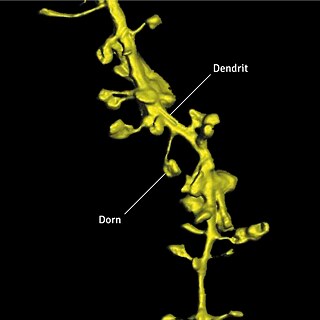
Learning and forgetting
One of the most important characteristics of the brain is its capacity to learn. In a newborn, the majority of brain cells and many neural pathways are already in place. But they only develop and become consolidated if they are used.
This means that the detailed structure of the brain is only created through learning. In humans this development takes until puberty. But the adult brain is also constantly being restructured – admittedly on a much smaller scale. In this way, humans are capable of lifelong learning.
Learning means that the connections between nerve cells in the brain change. This happens at the synapses – in other words where two nerve cells meet. The synapses not only transmit the nerve impulses from cell to cell, they are also the information stores of the brain. The more important the connection between two nerve cells is, the more synapses are created. By contrast, connections that aren’t used frequently disappear. Furthermore the synapses can conduct electrical signals from one cell to the next at a different intensity, in other words they can amplify or weaken them. This “synaptic plasticity” is the reason the brain remains adaptable and capable of learning. Whenever the brain stores something, the signal transmission is amplified. If the transmission is weakened or even interrupted, the brain forgets what it has learned.
The memory leaves traces
Thanks to new microscopy techniques, neuroscientists are looking with increasing precision at the structures that form the anatomical basis of learning. Tobias Bonhoeffer and his team from the Max Planck Institute of Neurobiology have observed how new connection points develop between nerve cells in the brains of mice: the dendrites of a single neuron feature tens of thousands of tiny protrusions called dendritic spines, on which most of the synapses are located. These spines are constantly undergoing change. This means that connections between the nerve cells can be established and broken very fast. If thought paths are not used any longer, the spines are reduced – we forget what we have learned. But some of those synapses always remain, they go into what you might call “standby mode”. Then if we focus on the same learning content again later, these synapses are used as a starting point for new connections. That’s why for instance we find it much easier to learn a foreign language the second time

Synaptische Dornen auf einem Dendriten einer Hippo-campus- Nervenzelle
| © Max Planck Institute for Neurobiology, Martinsried
Chaos in our heads
Adolescents brains are like a huge building site. Any synapses that are no longer needed disappear and an increasing number of axons become wrapped in myelin sheaths. This improves and speeds up the transmission of information. At the end of this process the brain is significantly more efficient and has neuronal networks that function effectively. During the changes things are often chaotic, because not all brain regions mature at the same speed. At this point the limbic system is developing quickly – the reward system and emotional processes gain importance. In the frontal lobe, where action is planned and different possibilities are compared, development is considerably slower. That explains why teenagers often behave in unexpected and risk-taking ways.

© Roman Zaiets /Shutterstock
Learning means that the connections between nerve cells in the brain change. This happens at the synapses – in other words where two nerve cells meet. The synapses not only transmit the nerve impulses from cell to cell, they are also the information stores of the brain. The more important the connection between two nerve cells is, the more synapses are created. By contrast, connections that aren’t used frequently disappear. Furthermore the synapses can conduct electrical signals from one cell to the next at a different intensity, in other words they can amplify or weaken them. This “synaptic plasticity” is the reason the brain remains adaptable and capable of learning. Whenever the brain stores something, the signal transmission is amplified. If the transmission is weakened or even interrupted, the brain forgets what it has learned.
The memory leaves traces
Thanks to new microscopy techniques, neuroscientists are looking with increasing precision at the structures that form the anatomical basis of learning. Tobias Bonhoeffer and his team from the Max Planck Institute of Neurobiology have observed how new connection points develop between nerve cells in the brains of mice: the dendrites of a single neuron feature tens of thousands of tiny protrusions called dendritic spines, on which most of the synapses are located. These spines are constantly undergoing change. This means that connections between the nerve cells can be established and broken very fast. If thought paths are not used any longer, the spines are reduced – we forget what we have learned. But some of those synapses always remain, they go into what you might call “standby mode”. Then if we focus on the same learning content again later, these synapses are used as a starting point for new connections. That’s why for instance we find it much easier to learn a foreign language the second time

Chaos in our heads
Adolescents brains are like a huge building site. Any synapses that are no longer needed disappear and an increasing number of axons become wrapped in myelin sheaths. This improves and speeds up the transmission of information. At the end of this process the brain is significantly more efficient and has neuronal networks that function effectively. During the changes things are often chaotic, because not all brain regions mature at the same speed. At this point the limbic system is developing quickly – the reward system and emotional processes gain importance. In the frontal lobe, where action is planned and different possibilities are compared, development is considerably slower. That explains why teenagers often behave in unexpected and risk-taking ways.

Cooperation partners

|

|



